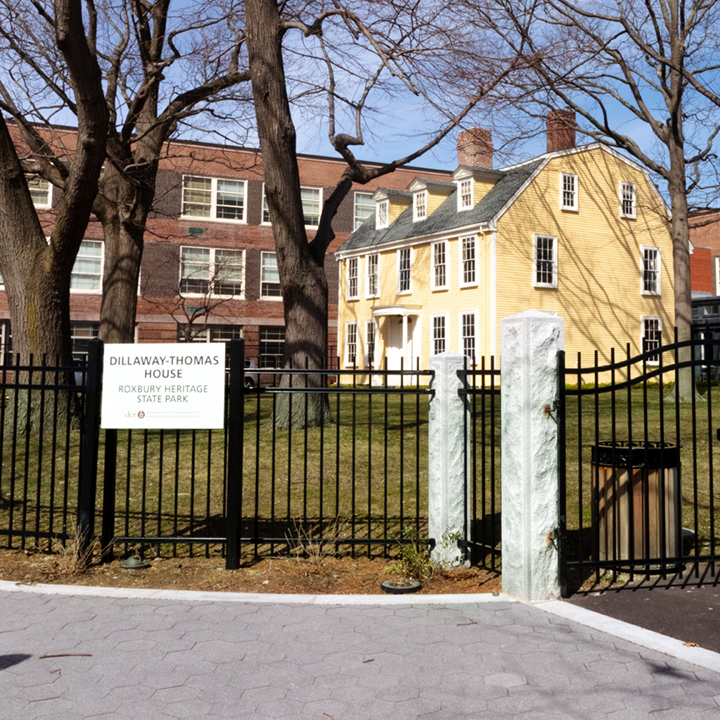Winner of a 2020 Boston Preservation Alliance Achievement Award
Roxbury, Massachusetts is 389 years old, and as a town, city, and now a neighborhood of Boston, has experienced all the significant upheavals and events of those last four (almost) centuries. Colonialism, war, slavery, immigration, the industrial revolution, civil rights, etc. all occurred after the Massachusett, Nipmuc, and other nations used this site long before William Pynchon and company established their church on a hill, the First Church in Roxbury in July 1632.
Content•Design Collaborative, along with Martha Lyons Landscape Architecture, Leonardi Aray Architects, Daphne Politis (Community Circle), Isabel Kaubisch (Clarendon Hill Consulting), and Karylin Crockett, were contracted in 2014 by the Department of Conservation and Recreation to create and implement a new Roxbury Heritage State Park. Located atop a puddingstone outcrop, the one-acre Park provides views to the city to the north, and South Boston and Dorchester to the east. The House, the oldest in Roxbury, offered 2,200 sf of exhibit space, that works out to a mere 600 square-feet per century.
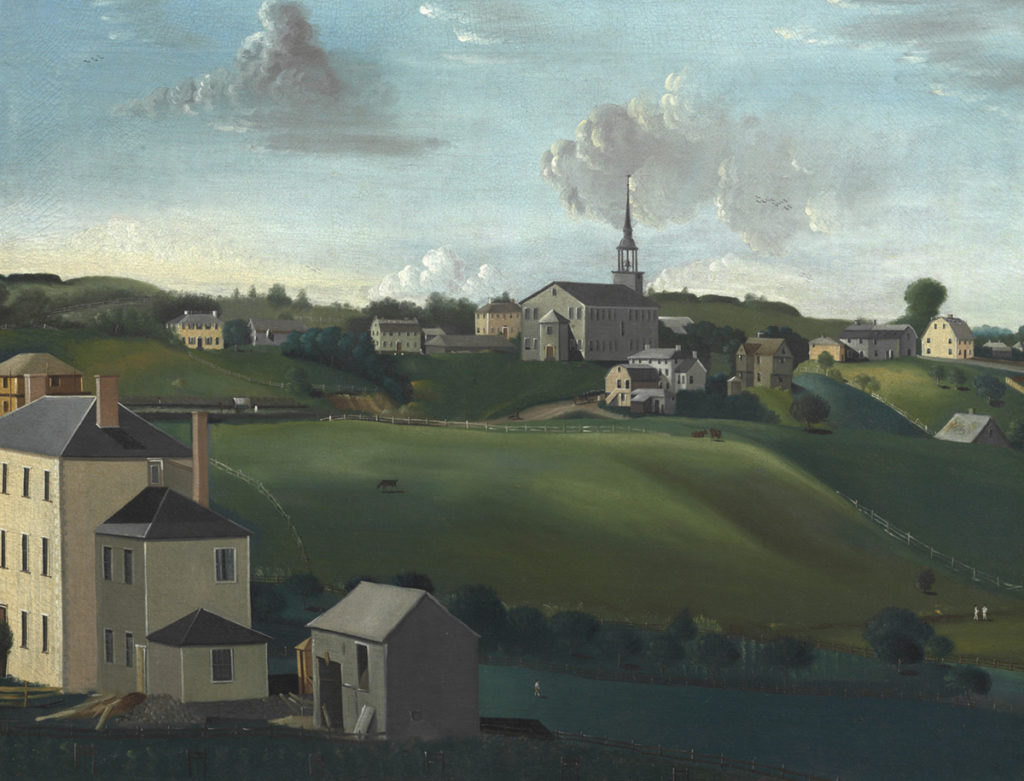
Art Inspiration
At our first workshop with the Roxbury Historical Society, the Department of Conservation and Recreation project manager Patrice Kish unveiled a color print of this painting. It served as a touchstone for the course of the project. Research shows that Penniman created this painting as a welcome distraction from his day job; painting clock faces for his boss, Aaron Willard, of Roxbury Willard-clockmaking fame. His more-famous brother Simon's clocks still tick in the United States Capitol and White House. The story goes that this painting was requested by Aaron to so his wife would not feel homesick after their move back to Grafton. When painted from Washington Street in Roxbury, clockmaking was the high-tech manufacturing of its day. The Willard shops relied on a network of 20 different businesses in a quarter mile radius. Their work presaged the industrial powerhouse Roxbury would become within the next 60 years.
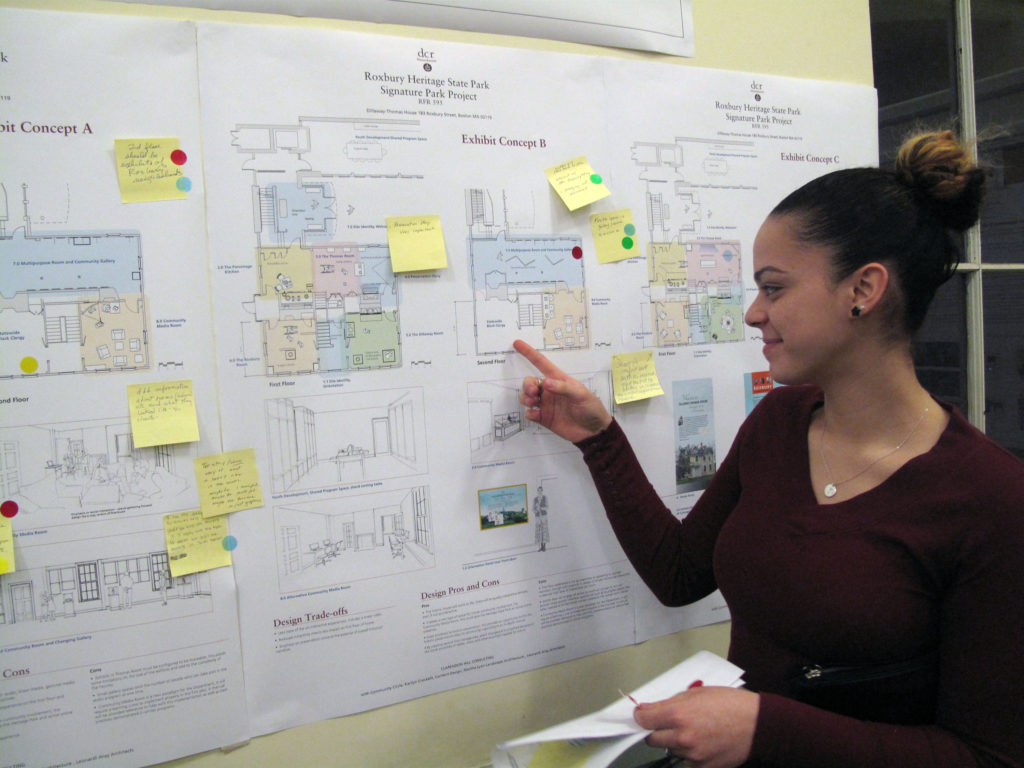
Let the people speak
Since the Department is responsible for the "health and happiness of people across Massachusetts," our civics lesson began with a formidable series of public workshops and presentations. Event organizers Daphne Politis and Isabel Kaubisch expertly managed to set up three public review events during the winter and early spring of 2014. The public workshops made sure everyone was heard, for instance; one thorny issue was to have a fence or not around the site, a request was made for wifi on site, and the idea sounded that the site would act as a portal to other cultural sites in Roxbury.
The concept plan
The scope of work included a formal interpretive report, facilitated and produced by Faye Goolrick with significant input from the Roxbury Historical Society and other local stakeholders. We completed a SWOT analysis and concept design and rolled it into a report in three months. Our interpretive criteria: It's all about Roxbury, not Boston history, if it did not happen here in Roxbury it is not included in the exhibit, plus; focus on African American history. Our overarching theme; The hill on which stands the Dillaway-Thomas House was once the highest point at the nexus of a land bridge where once the people of the woodland passed on their way to the rich waters of the harbor. This house and site has survived intact for the entire course of US history and continues to thrive today as a vibrant, living, symbol of the enduring spirit of Roxbury.
With so much history to interpret and so little space, the development team proposed an epoch per room at the Dillaway-Thomas House. Visitors enter the House from the accessible annex, the first thing you encounter is a cavernous ten-foot wide cooking hearth, so we deemed this space the Parsons Kitchen, and it covered the pre-revolutionary war era. This gallery was followed by the Revolutionary War gallery, or the Thomas Gallery, for General Thomas who took residence there during the Siege of Boston. Next comes the Dillaway Room, named after Charles K. Dillaway, a scholar and early headmaster of Boston Latin. The next exhibit area is the Historic Hallway and the 20th Century Roxbury Room. Upstairs the House featured a gallery loosely dedicated to 21st Century Roxbury accompanied the multi-purpose changeable art gallery and community meeting space.

This Old House
Considered a historic site because of its role in the Revolutionary War, the House had a cast plaque fastened to it after the Dillaway family's 67-year residence. After a decade of neglect, it was restored by local historic house pioneer, Frank Chouteau Brown. He added some fanciful colonial restoration elements along with the current mix of federal and latent Georgian details. It was completed in time for a grand dedication for the George Washington Bicentennial in 1932, because he visited, (though did not sleep) the House during the Siege. Looking healthy in the 1940s, the House again fell into neglect and was almost burned down in an arson attempt in 1979 when Boston was known as the arson capital of the world.
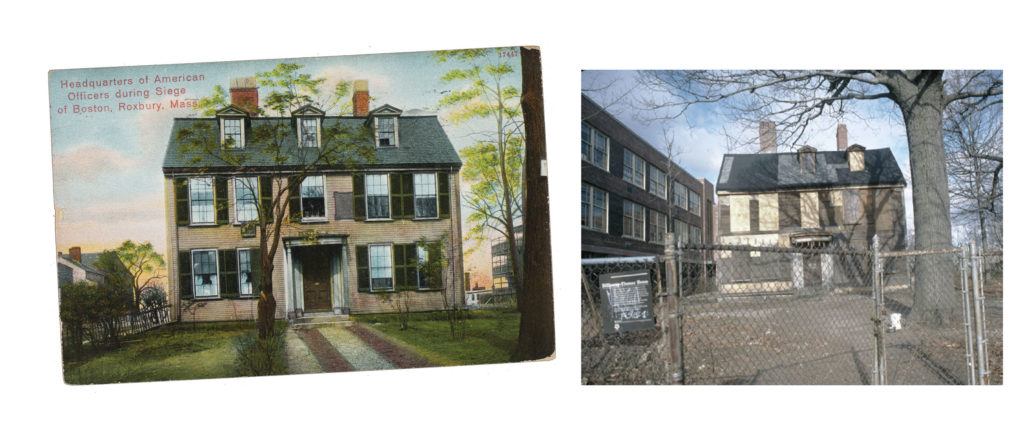
The House was practically empty at the start of the project; it served as much as a meeting place for the community as a place of interpretation. Glass panel labels overlaid exposed sheathing and joists to provide a remodeling history of the House. Otherwise, a rare framed handbill or photo propped on the mantle referred to Roxbury's history. The Roxbury Historical Society, incorporated in 1901, used the House as its headquarters.
The Colonial Kitchen
Amos Adams, the Harvard-educated pastor, preached at the First Church in Roxbury across the street. He went through two wives, Elizabeth, and Abigail, and was survived by his third, Sarah, with a total of eight-plus children between them. We interpret the lives of these hard-working colonial ladies with a fully-featured hearth, hearth table with inlaid graphics, and interactive cupboards. On the doors of the cupboards, which may be original to the 1755 house, are prompts, Who lived here with Amos Adams? And What did they own? Open the door, and the cupboard is stocked with the answers.
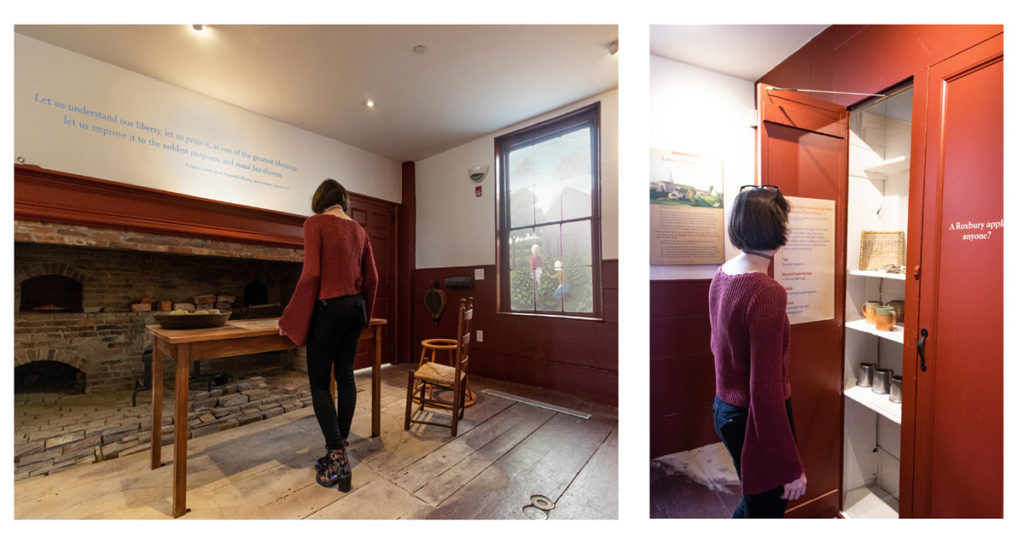
On the hearth table, a cookbook contains everyone's favorite colonial recipes such as Bird's nest Pudding or Dressed Macaroni.
Slavery and Dissent in Roxbury
There is no evidence of slaves at the House, but plenty on the existence of slavery in Roxbury. Several major streets, such as Ruggles Street, are named after slaveholders. The Roxbury Historical Society identified a 1771 tax inventory of Roxbury, it showed that there were 362 citizens and 21 "servants for life." The exhibit features a bill of sale of a negro man by the name of Boston and a broadside lamenting the lack of oversight of negro servants,
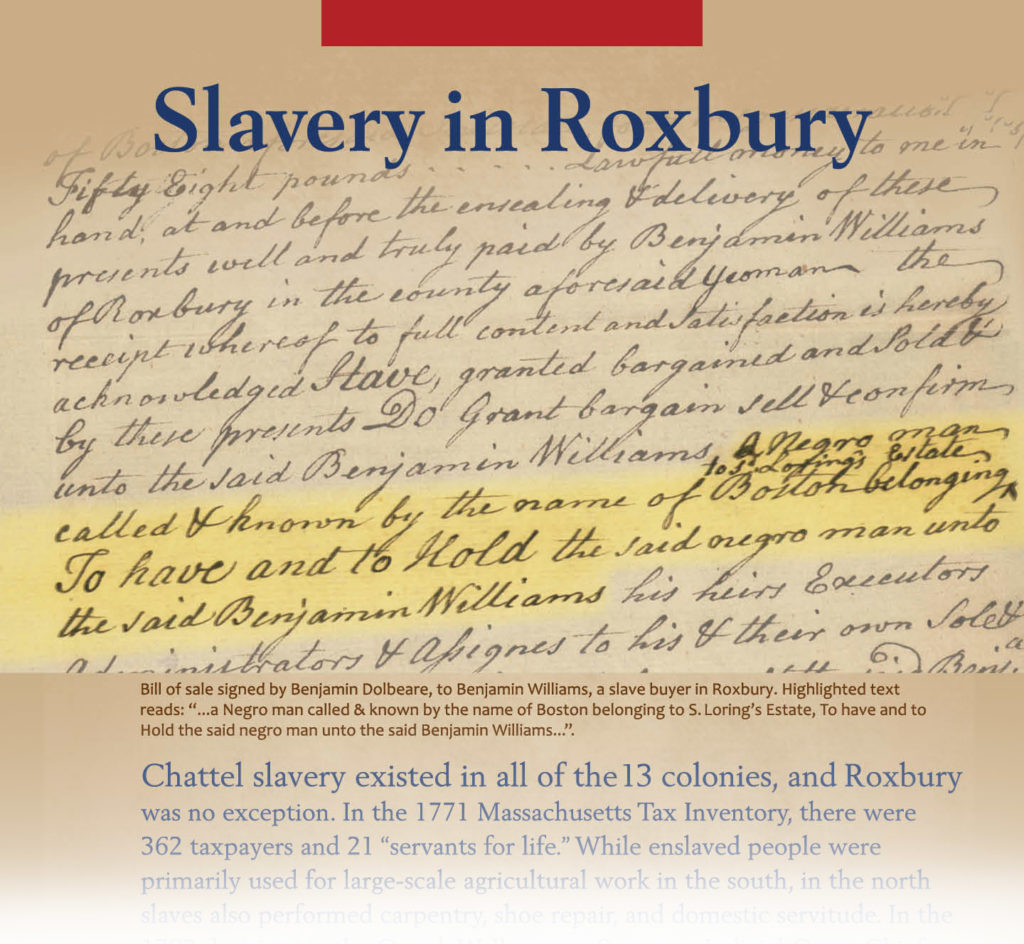
Amos Adams, the pastor who lived in the House before the Revolutionary War was a patriot. He urged the citizens of Roxbury to produce goods of their own rather than import them from England. To set an example, in 1768, Elizabeth Adams, the pastor's wife, organized a spinning bee in which 60 women gathered at the House and spun "one hundred score of linen yard." Apparently, there were many approving onlookers.
Boston Besieged and the General
With all hell breaking loose in the spring of 1775, the leaders of the colonial rebels appointed veteran John Thomas as a leader of the militia tasked with keeping the British troops in Boston. Roxbury stood on one side of the only ground route called Boston Neck. Our exhibit features a letter from the collection of the Massachusetts Historical Society where General Benjamin Lincoln informs Amos Adams that "It would be quite agreeable for General Thomas to remove into your house…". Other experiences are a recreation of General Thomas's field desk where you can hear a dramatic reading of one of his many letters to his wife and an interactive map placing the House in context of the siege of 1775-76.
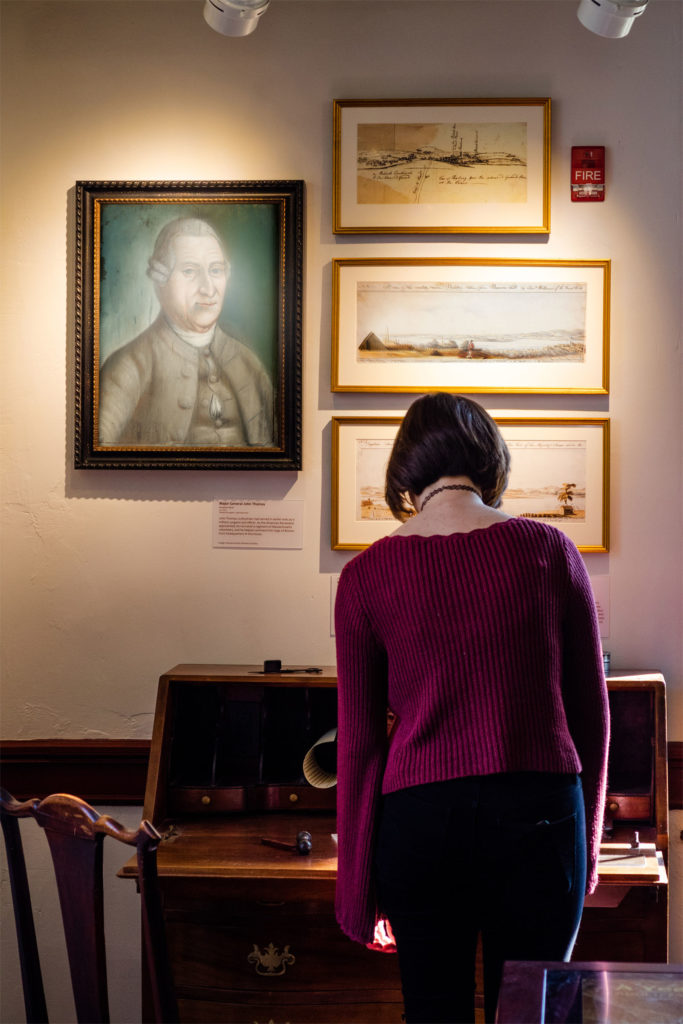
Roxbury Transformed, the Dillaway Room
The map of 1832 Roxbury shows long country roads lined with occasional dwellings, with a dense cluster around the First Church in Roxbury. There are rolling hills on the unoccupied spaces, most likely used for farmland. Just 58 years later little of this open space remained, Roxbury was a dense as any other neighborhood in Boston, though West Roxbury remained suburban. In our small gallery, we focused on the lively domestic environment that was the Dillaway family, with over ten family members and domestic staff living there at any one time it is a wonder that Charles Dillaway had room to run his school for girls. Mr. Dillaway was former headmaster at Boston Latin, an author, and participated in the first Japanese student exchange program. Fragments of a 19th century Satsuma vase were found on the site, perhaps a gift from the students?
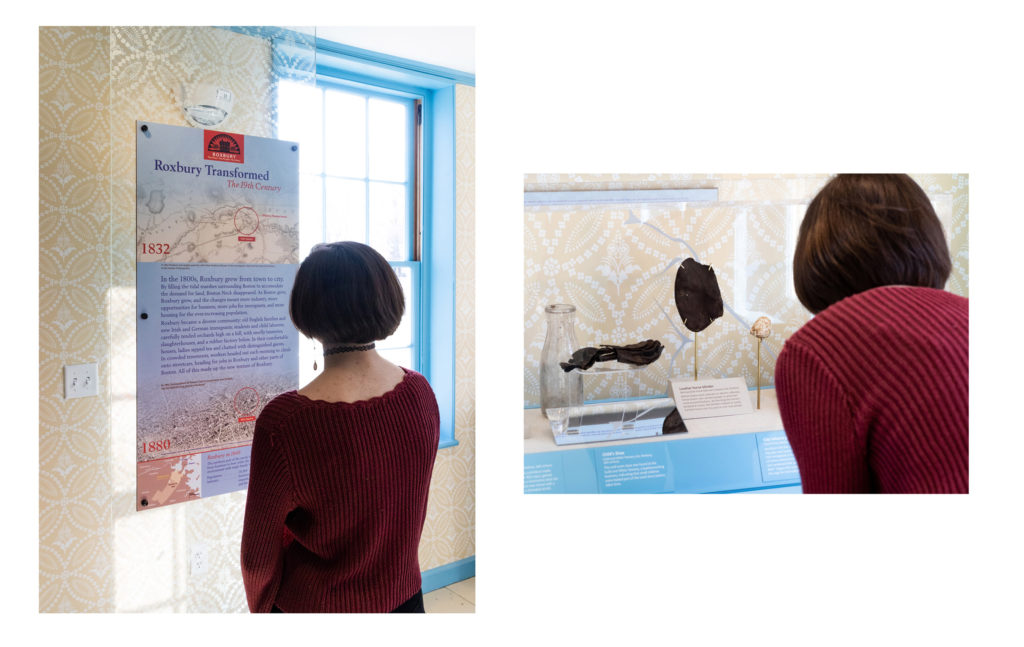
In an excerpt from Roxbury Magazine in 1899, found by our team writer and researcher Carrie Brown, a former student described Dillaway's classroom atmosphere as being "sunny and loving." It went on to say "At recess we walked in the garden at the back of the house or were allowed to go into the parlor and play the piano," hence the reproduction Chickering piano in our exhibit. The Victorian-style center table is where an interactive foosball exhibit challenges visitors to assemble various maps of Roxbury correctly.
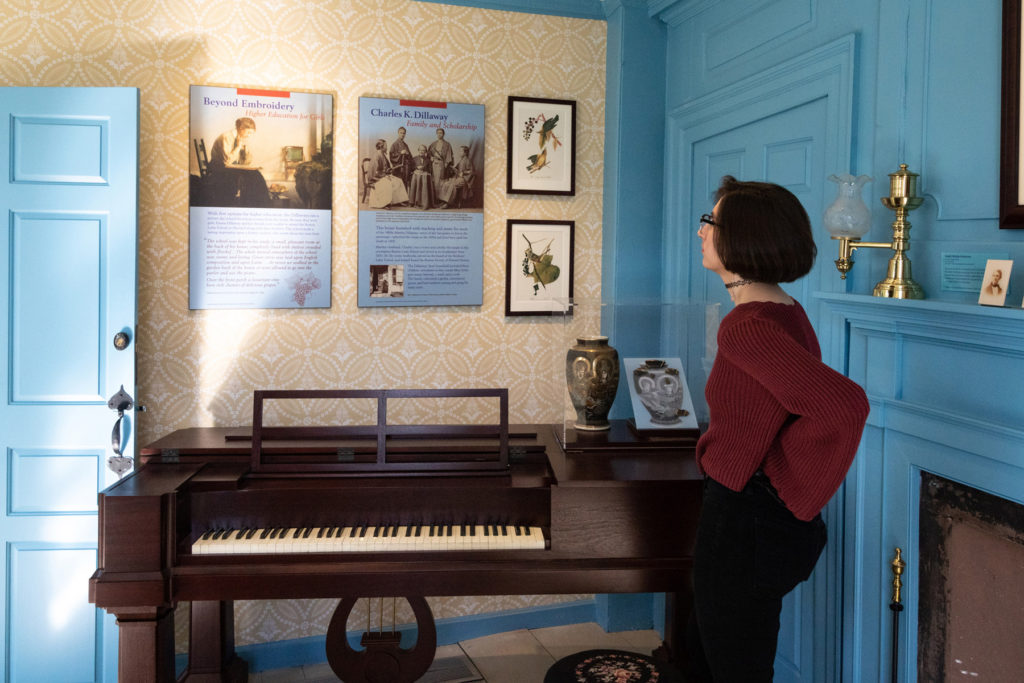
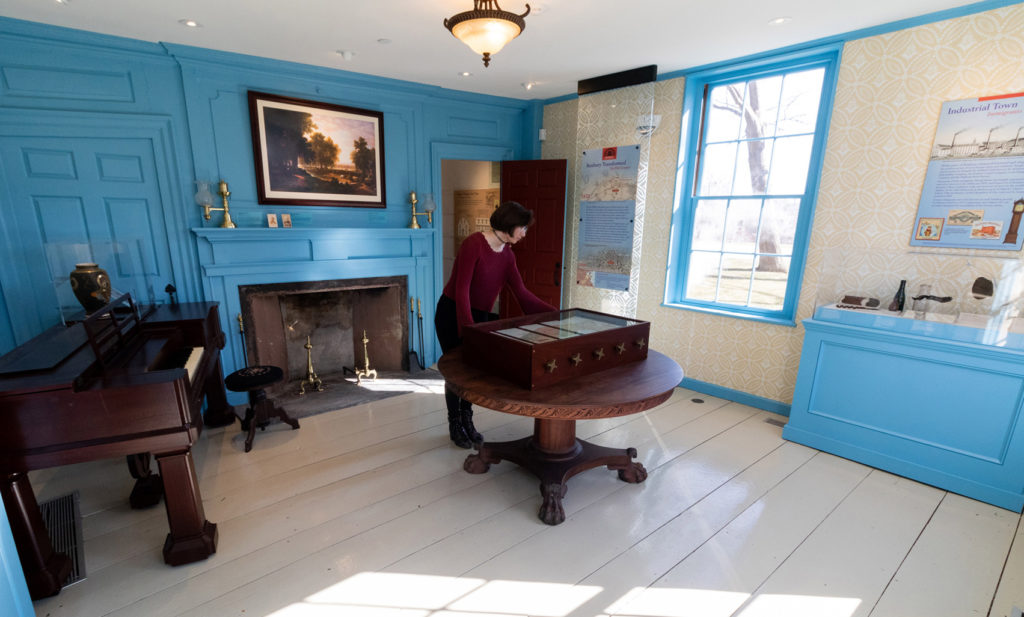
Historic Hallway
The entry and center staircase is the one portion of the House least affected by Chouteaus imaginative restoration or 1979 fire. The elegantly spaced stairway rises much more relaxed than your typical short tread, steep-pitched New England farmhouse stair. We feature a Willard-style longcase clock, and the framed Penniman painting, a reproduction, of course, a permanent loan from the Art Institute of Chicago could not be arranged.
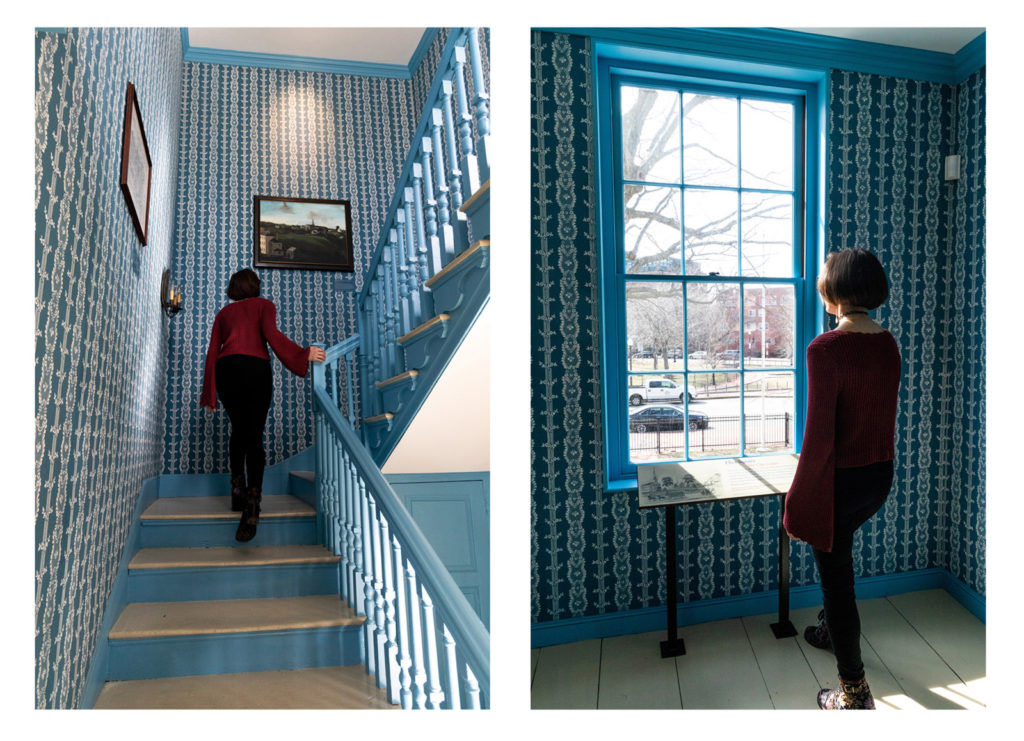
New Voices, the 20th Century
The population changed in size and shape in Roxbury in significant ways. Brahmins like Mr. Dillaway gave way to Irishmen, who in turn rubbed shoulders with Italian, Latvian, Jewish, and German immigrants. After the Second World War, the great migration enlarged the existing African American population to a near majority, filling in when the last significant subgroup, the Jewish community, departed for the suburbs in the 1970s. Today Roxbury is the nexus not only to African American culture but Caribbean and African people. An audio station, paired with a flip book, has the voices and stories of prominent community leaders such as Michael Haynes and Melnea Cass, graphic panels feature the art of John Wilson and a photograph of Martin Luther King Jr. leading his first march outside of the south from Roxbury. The featured painting over the mantle is a work by Alan Crite, an artist who featured Roxbury and South-end neighborhoods in his work.

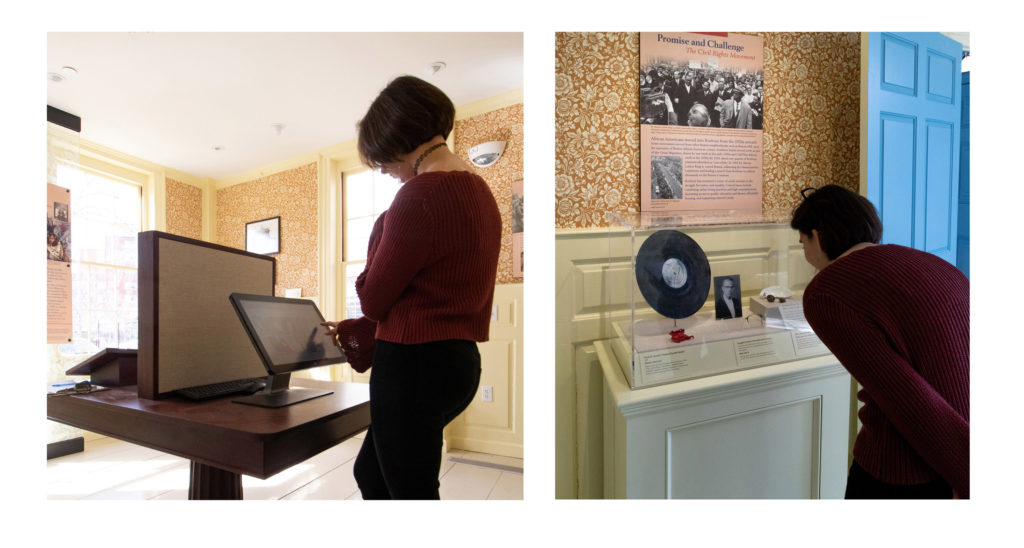
Roxbury Today
The most popular exhibit concept presented during the community meetings was the gestural touch-exhibit that would show the changes to the Roxbury area through the ages, from Nipmuc settlement to metropolis. With the talents of Northern Light Production, this digital pipe-dream became a reality. Over 62 feature locations across eight moments in history makes this exhibit the star of the show for all ages.
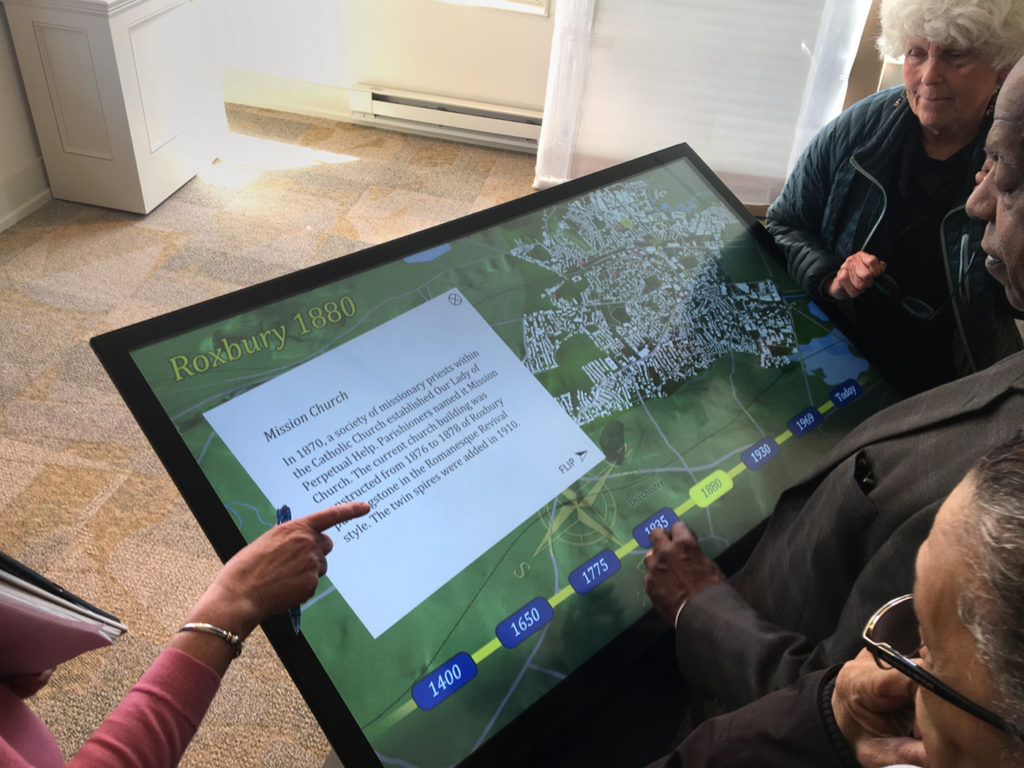
There was one other requirement from the Roxbury Historical Society—all maps of Roxbury must show the 1868 borders when Roxbury was annexed to Boston. The boundaries you see on your smartphone reflect the Boston Redevelopment Authority's idea on what constitutes the neighborhood of Roxbury. My mother grew up on Mission Hill and considered her Irish immigrant community to be part of Roxbury, now considered a separate area altogether by the city of Boston. When the historic boundaries of Roxbury are overlaid on the map of the city today cultural institutions such as the Museum of Fine Arts and Northeastern University as well as the entirety of the Longwood Medical District are all part of what Roxbury offers the city.
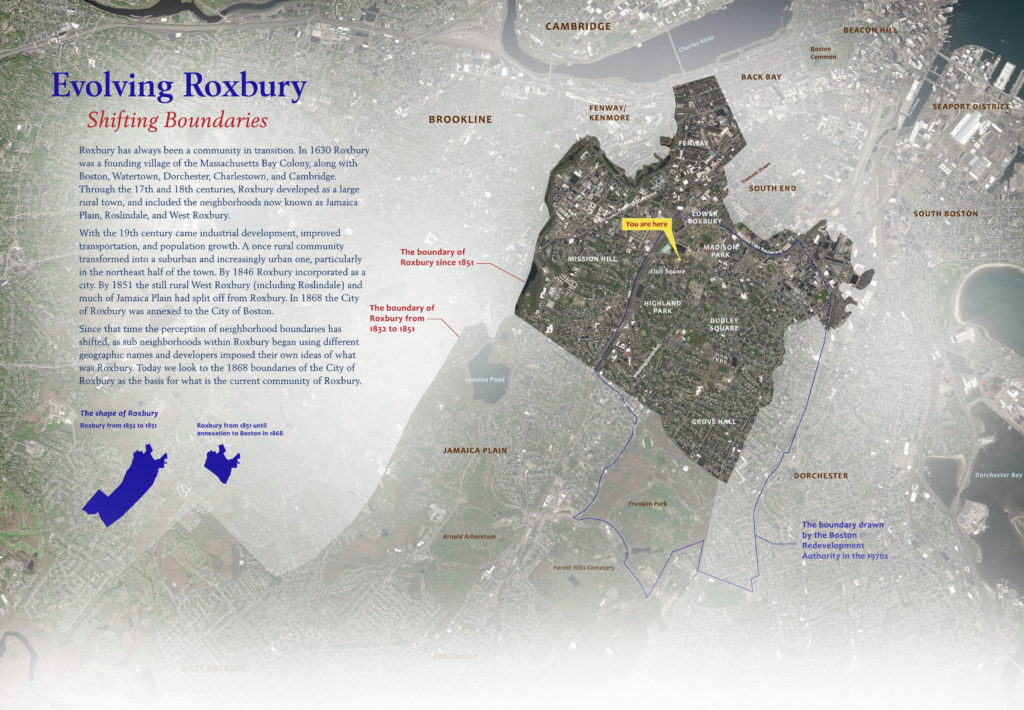
The Park
The landscape designer had two elements on site to build on. First, a puddingstone wall, a local conglomerate from which many Boston edifices are constructed. There was an active Roxbury quarry on Parker's Hill for decades. Plus, the existing apple trees from the historic orchard that produced the Roxbury Russet cultivar, not so popular today because it isn't unnaturally red, but it is reputed to be a keeper, that is, it has a long shelf life. Just like the exhibits, we hope. Visit if you are in the neighborhood, Roxbury's history and significance are now revealed!
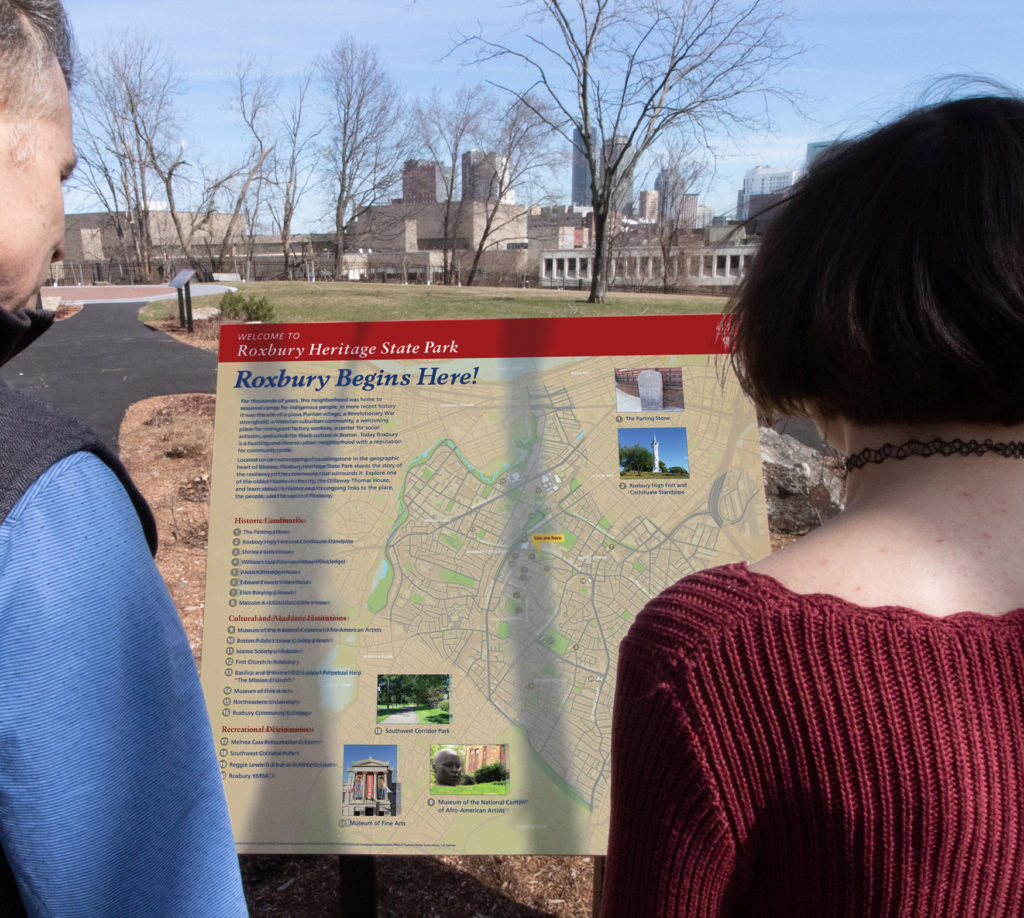
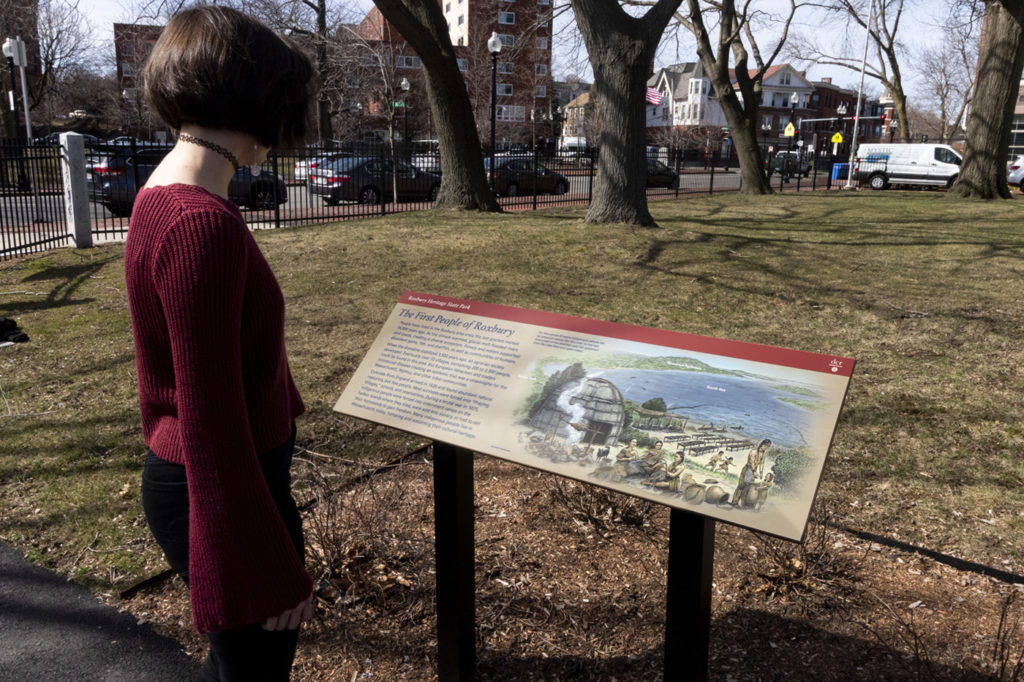
For more on the art used in the exhibit read more http://contentdesign.me/it-takes-a-village-of-institutions-to-make-an-exhibit/
Many thanks to all who persevered and collaborated on this exhibit: Patrice Kish, Jessica Rowcroft, and Ellen Berkland (DCR); Marcia Butman and Byron Rushing (Roxbury Historical Society), and Barry Gaither (National Center of African American Artists)
The exhibit team: Development: Faye Goolrick, Edward Malouf, Carrie Brown, Carol Lieb; Design: Edward Malouf, Neal Mayer; Writing & Research: Carrie Brown, Carol Lieb, Edward Malouf; Historic furnishings: Janice Hobson; Graphic Design: Helen Riegle (HER Design), Edward Malouf, Carol Lieb; Media: Lenny Rotman (Northern Light Productions); Media installation: Steve Gregory (New England Technology Group; Exhibit Construction: Allan McNab (Mystic Scenic Studios), photography by George Malouf www.georgemalouf.com


